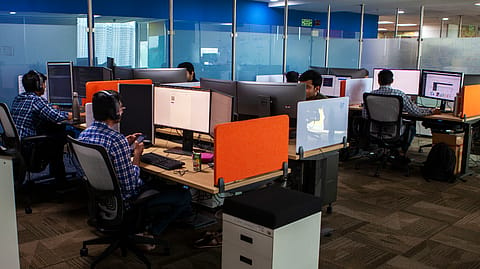Services sector sees stronger expansion in February
Boosted by improving domestic and international demand, new orders placed with Indian services companies rose at a faster rate during February.

India’s HSBC India Services PMI (Purchasing Managers’ Index) rose from January's 26-month low of 56.5 to 59 in February, indicating a sharp rate of expansion that was well above its long-run average. A reading above 50 indicates an overall increase in output.
Boosted by improving domestic and international demand, new orders placed with Indian services companies rose at a faster rate during February, the PMI survey showed. The uptick in growth underpinned a quicker expansion in output and a substantial increase in employment.
“Global demand, which grew at its fastest pace in six months according to the new export business index, played a major role in driving output growth for India’s services sector. Meanwhile, job creation and charge inflation remained strong during February. Looking ahead, business sentiment remains broadly positive, but did slightly slip last month to its lowest level since August 2024,” said Pranjul Bhandari, chief India economist at HSBC.
Although firms noted that cost burdens rose further, the rate of inflation receded to a four-month low. Meanwhile, the rate of increase in output prices was broadly similar to January and therefore remained above its long-run average. Productivity gains, favourable underlying demand and greater intakes of new business were the key determinants of output growth, anecdotal evidence showed.
The upturn was historically strong and quicker than that seen in January. Gains in international orders supported this trend, with service providers reporting better demand from clients in Africa, Asia, Europe, the Americas and the Middle East. Overall, external sales expanded at the fastest pace in six months.
In order to accommodate for rising new business and alleviate capacity pressures, Indian services firms continued to pursue recruitment drives. Employment expanded sharply, and at one of the fastest rates seen since data collection began in December 2005.
Although labour was identified as a source of cost pressures – via additional recruitment, higher salaries and overtime payments – monitored companies also signalled greater outlays on food, material and packaging. The overall rate of cost inflation nevertheless receded to a four-month low and was aligned with its historical trend.
Recommended Stories
The rate of charge inflation was broadly similar to January, therefore remaining above its long-run average. Survey members commented that additional cost burdens had been passed on to their customers.
Despite ongoing increases in staff numbers, Indian service providers continued to see their backlogs piling up in February. Advertising, better customer relations, efficiency gains and healthy demand conditions all underpinned upbeat projections for output in the year ahead. Around one-quarter of survey members forecast growth in the year ahead, while fewer than 2% were pessimistic. The overall level of positive sentiment slipped to a six-month low, however.
Aggregate output in India increased sharply in February, and at a quicker pace than that seen at the start of the 2025 calendar year. The HSBC India Composite Output Index rose from 57.7 to 58.8, indicating a substantial rate of expansion. The acceleration in growth was centered in the service economy, as manufacturers registered a slower upturn. Private sector sales rose at a sharp rate that was quicker than in January.